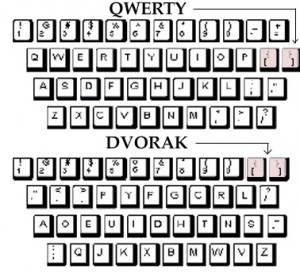
Sometimes the best products and business models don’t “win” in the market, while lesser products and plans triumph. Cases in point: the dominance of the QWERTY keyboard over better designs (like the Dvorak), and—in the days of Ye Olde Visual Media—the way the VHS standard consigned BetaMax, with its superior picture quality, to the dustbin of history.

Economists have long puzzled over these failures and have advanced a number of explanations, including the compelling theories of Brian Arthur, whose work on increasing returns and market “lock-in” was instrumental in the US government’s anti-trust case against Microsoft. As Arthur has shown, merely having a head start in terms of market share can allow an inferior product to continue growing that share until it dominates the market, shutting out any competition.
But these cases also showcase the value that economic sociology can add to our understanding of markets, particularly through the lens of culture—the sort of variable that gets thrown into the dreaded black box of “preferences” in economic models. Black boxes exist in the world of academic theory to contain factors that are unknown, perhaps unknowable; this often gets interpreted to mean that the factors are not worth knowing about. Thus, the origins of preferences, and the ways preferences change, are treated by most economists as uninteresting and irrelevant.
Yet for sociologists, these are the most interesting things about economic behavior. Culture, class, identity and ideology—core issues in sociological research—all play a role in shaping preferences. These forces are not easy to model, which is a major reason they get left out of economic scholarship, where elegance and parsimony are valued above empirical verisimilitude. So, as one classic article put it, sociologists get “dirty hands” from dealing with lots of data and variables, while economists construct “clean models” that exclude such messy complexities.
What sociological theories may lack in “cleanliness,” however, they make up for in explanatory power. I was struck by this recently while contemplating a puzzling business failure in my own backyard: the Belgian supermarket chain Delhaize shut its doors in Cologne and Aachen, the two cities where the firm had tried to gain a foothold in Germany. Here were stores vastly superior to their competition—selling a much broader and higher-quality range of goods than anything available in local grocery chains, all at very reasonable prices—and yet the business failed. 
Adding to the mystery, Delhaize had long ago proved that their business model transplanted well to other cultures by launching the chain to great success in Asia and the US. Yet they couldn’t make a go of it just across the border from the firm’s headquarters. High quality, competitive pricing and good locations weren’t enough to make the model work in Germany.
The loss was keenly felt in the expat community here in Cologne. People don’t usually get sentimental about grocery stores, but Delhaize inspired extraordinary loyalty and appreciation among people who cared about good food. If you come from a place where a wide variety of fresh, high-quality, attractive foods–particularly fruits and vegetables–are readily available, then it’s a huge shock to walk the aisles of a German grocery store. The baked goods—bread and pastries—are terrific, and justly celebrated. But the produce and meats are really dismal, even in specialty shops, and the supermarkets are quite depressing. I come from the US, but I’ve heard the same refrain from friends and colleagues who hail from Turkey, France and Thailand.
All of us were struck to find, here in the wealthiest country in Europe, that the fruits and vegetables often look quite bedraggled, as do the meat and fish selections. Even the very expensive places tend to have the kind of quality that you would expect at a Stop-n-Shop in the US, and the selection is both unreliable and extremely limited. Some days you’ll find cucumbers, some days there will be none. There will always be apples, but at most two or three kinds instead of the six to 10 varieties you typically find in a big-city American grocery store. I have never seen a salad bar here, although I’ve offered a €100 bounty for the past three years to anyone who can show me one in a German grocery. You can compensate somewhat by going to a different specialty store for each class of food you want—fruits, meats, etc.—but the quality and reliability of the selection still isn’t very good. And few people have time to schlep to a half dozen different stores to buy their food.
These are not life-and-death issues, but they make a big difference in one’s ability to plan meals, follow recipes, or just enjoy favorite foods. When I asked German sociologist colleagues about this, I was surprised to find that they knew exactly what I was talking about: they acknowledged the poor quality of the produce and meats in German grocery stores, and blamed it on the carry-over of a wartime mentality. That is, the older generation in Germany—the parents of people in their 40s and 50s—grew up with rations and privation, and a mindset that meant eating was about survival, not enjoyment. They fed their kids for quantity of calories, not quality, creating tastes, expectations and norms that have persisted into the present day.
Tastes, expectations, norms? If you join economic sociologists in unpacking the black box of preferences, these are exactly the sorts of things you find. Clusters of these factors become the most powerful explanatory variables in sociology, like identity and culture.

How does this help us understand the Delhaize closures in Germany—and even predict such events in future? For me, the “missing link” cropped up in a presentation by Professor Sophie Quellier of Sciences Po, who gave a talk last summer at SASE (the Society for the Advancement of Socio-Economics) on the market for peaches in Paris. She made a compelling case that consumers don’t automatically choose the highest-quality goods, but must be taught to recognize them, value them, and most importantly, buy them.
If this sounds similar to the argument about cultural products in Distinction, it is: Quellier’s thesis could be described as “Bourdieu goes grocery shopping.” For those not familiar with Bourdieu’s magnum opus, the great French sociologist used consumer survey data to show how class distinctions are reproduced through matters of taste. He finds that seemingly personal preferences—such as aesthetic choices in furniture, clothing or art—are actually learned social behaviors. Moreover, those choices have little connection to sensory experiences (such as pleasure) but rather serve to distinguish members of different classes from one another, rendering visible the structure of social hierarchy.
Quellier’s work follows the process of “educating” consumers to prefer a fine peach over less-flavorful and less-expensive varieties. It requires a sustained, intense effort, involving everything from advertisements to public taste tests, à la the “Pepsi Challenge.” To see how this works, check out this ancient Pepsi Challenge ad (with Welcome Back Kotter‘s Gabe Kaplan, of all people), which seeks to change consumer preferences with a variety of rhetorical strategies, including both conformity pressure (“Nationwide, more people prefer the taste of Pepsi to Coca Cola”–join the group!) and appeals to individuality (“Let your taste decide”–don’t follow the Coke-drinking herd!).
This series of television spots, along with print ads and in-store tastings—a veritable marketing juggernaut that carried on for years during the 1970s and 1980s—never succeeded in dislodging Coke from its position as the number one soft drink in America. Even if Pepsi was the superior product, by virtue of being chosen as “best-tasting” by the majority of test participants, it couldn’t make much of a dent in consumer preferences.
As a recent series of MRI studies showed when replicating the Pepsi Challenge, drinking Pepsi activates a part of the brain connected to the physical sensation of taste, while Coke activates a part of the brain connected with feelings about identity. Remarkably, beliefs and ideas win out over embodied sensory experience.
Which goes a long way toward explaining the Delhaize failure in Germany. Quellier’s work, combined with “neuro-marketing” research, suggest two conclusions that are particularly relevant to this empirical case:
- preferences connected with food consumption are deeply-rooted and slow to change (unlike say, preferences for fashions in clothing or technology)
- any effort to change food-related consumer preferences have to contend more with ideas than sensory experience—eating and drinking have more to do with the sense of self than the sense of taste
In a culture where food traditions, family culture and national history come together in a cuisine of bland flavors, fried meats and few fresh fruits and vegetables, Delhaize had little chance of succeeding. If it had put in the kind of cultural reprogramming effort described by Quellier, Delhaize might have been able to carve out a stable niche in Germany. Would it have been worth it economically? Hard to say. But without such an effort, the chain was doomed.
This also implies something about Delhaize’s successes internationally: the extent to which the chain has thrived outside of Belgium may have less to do with the quality of their products than the cultural fit between the values and preferences Delhaize represents (e.g., high quality and broad selection are important) and those of the countries where it has launched its stores. This foregrounds the role of culture in business, in everything from international expansion to mergers and acquisitions, and the value of sociological accounts in clarifying how culture works. One wonders what would happen if more business leaders had backgrounds in sociology rather than finance.